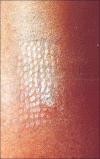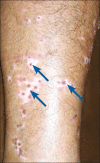The concept of stability of vitiligo: a reappraisal
- PMID: 22615501
- PMCID: PMC3352651
- DOI: 10.4103/0019-5154.94271
The concept of stability of vitiligo: a reappraisal
Abstract
Stability is taken as the most important parameter before opting for any transplantation technique to treat vitiligo. But, simultaneous donor site repigmentation and depigmentation of grafts at the recipient site has been noted. Similarly donor site depigmentation with complete repigmentation of the recipient area with pigment growing out from each graft has been observed. Successful repigmentation after regrafting in previous punch failure cases has also been reported. Koebner's phenomenon from history (Kp-h) and test grafting were the only available indicators to assess stability. It is quite ironic to note that even after four decades of experience in vitiligo surgery, there seems to be little consensus among workers regarding the optimal required period of stability. Moreover, the exact concept of stability in vitiligo is itself still not transparent and defined beyond doubt Overdependence on KpH or TG may be sometimes misleading in vitiligo. These two reveal the apparent clinical stability only and that may not be the true reflection of stability status of the disease at the molecular level. Antimelanocyte cytotoxic reactivity was observed among CD8+ TCC isolated from perilesional biopsies of patients with vitiligo. An attempt should be made to clearly fathom and define stability, not merely only on clinical ground but along with electron microscopy and histoenzymological analysis of the perilesional and nonlesional skin of vitiligo patients. Probably some growth factors which are responsible for both mitogenic and melanogenic stimulation of melanocytes should also be taken into account. Some serological test(s) could guide us to measure these growth factors.
Keywords: Vitiligo; vitiligo grafting; vitiligo stability.
Conflict of interest statement
Figures










Similar articles
-
Treatment of vitiligo with autologous epidermal transplantation using the roofs of suction blisters.Hong Kong Med J. 1998 Jun;4(2):219-224. Hong Kong Med J. 1998. PMID: 11832577
-
Long-term results of 2-mm punch grafting in patients with vitiligo vulgaris and segmental vitiligo: effect of disease activity.Br J Dermatol. 2009 Nov;161(5):1105-11. doi: 10.1111/j.1365-2133.2009.09367.x. Epub 2009 Jun 22. Br J Dermatol. 2009. PMID: 19673878
-
Vitiligo: characterization of melanocytes in repigmented skin after punch grafting.J Eur Acad Dermatol Venereol. 2015 Mar;29(3):581-90. doi: 10.1111/jdv.12647. Epub 2014 Aug 4. J Eur Acad Dermatol Venereol. 2015. PMID: 25089006
-
Noncultured Epidermal Suspension in Vitiligo-A Review of Origins, Modifications, and Innovations for this Surgical Masterstroke!Skinmed. 2021 Dec 1;19(6):419-423. eCollection 2021. Skinmed. 2021. PMID: 35022112 Review.
-
Koebner's phenomenon in vitiligo: European position paper.Pigment Cell Melanoma Res. 2011 Jun;24(3):564-73. doi: 10.1111/j.1755-148X.2011.00838.x. Epub 2011 Mar 7. Pigment Cell Melanoma Res. 2011. PMID: 21324101 Review.
Cited by
-
Serendipity and its role in dermatology.Indian J Dermatol. 2015 Mar-Apr;60(2):130-5. doi: 10.4103/0019-5154.152504. Indian J Dermatol. 2015. PMID: 25814699 Free PMC article.
-
Stability in Vitiligo: Is there a Perfect Way to Predict it?J Cutan Aesthet Surg. 2013 Apr;6(2):75-82. doi: 10.4103/0974-2077.112667. J Cutan Aesthet Surg. 2013. PMID: 24023428 Free PMC article. Review.
-
Segmental and generalized vitiligo: both forms demonstrate inflammatory histopathological features and clinical mosaicism.Indian J Dermatol. 2013 Nov;58(6):433-8. doi: 10.4103/0019-5154.119949. Indian J Dermatol. 2013. PMID: 24249893 Free PMC article.
-
Grafting in vitiligo: how to get better results and how to avoid complications.J Cutan Aesthet Surg. 2013 Apr;6(2):83-9. doi: 10.4103/0974-2077.112668. J Cutan Aesthet Surg. 2013. PMID: 24023429 Free PMC article. Review.
-
Transverse Needling After Autologous Mini-Punch Grafts Improves Repigmentation in Stable Non-Segmental Vitiligo.Clin Cosmet Investig Dermatol. 2021 Jul 6;14:827-835. doi: 10.2147/CCID.S315407. eCollection 2021. Clin Cosmet Investig Dermatol. 2021. PMID: 34262320 Free PMC article. Clinical Trial.
References
-
- Orentriech N, Selmanwitz VJ. Autograft repigmentation of leucoderma. Arch Dermatol. 1972;105:734–6. - PubMed
-
- Falabella R. Repigmentation of segmental vitiligo by autologous mimigrafting. J Am Acad Dermatol. 1983;9:514–21. - PubMed
-
- Halder RM, Breadon JY, Johnson BA. Micropigmentation for the treatment of vitiligo. J Dermatol Surg Oncol. 1989;15:1092–8. - PubMed
-
- Behl PN. Treatment of vitiligo with homologous Thiersch's Skin grafts. Curr Med Pract. 1964;8:218–21.
-
- Kiistala U, Mustakallio KK. In vivo separation of epidermis by production of suction blisters. Lancet. 1964;1:14444. - PubMed
LinkOut - more resources
Full Text Sources
Research Materials
Miscellaneous
